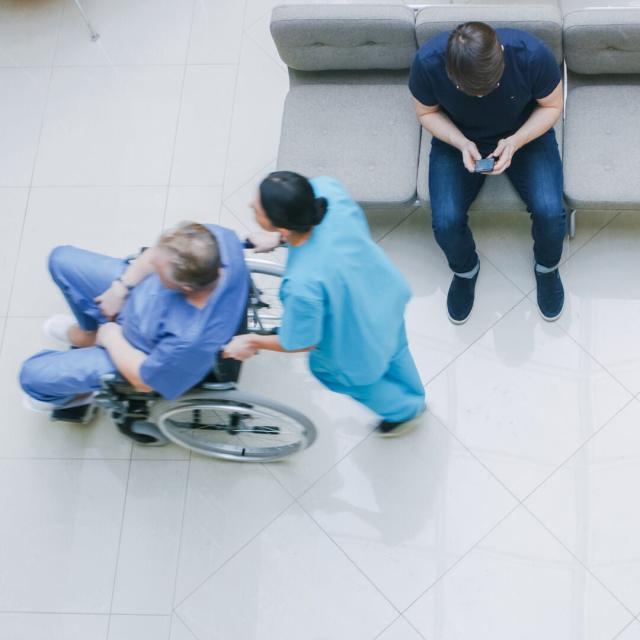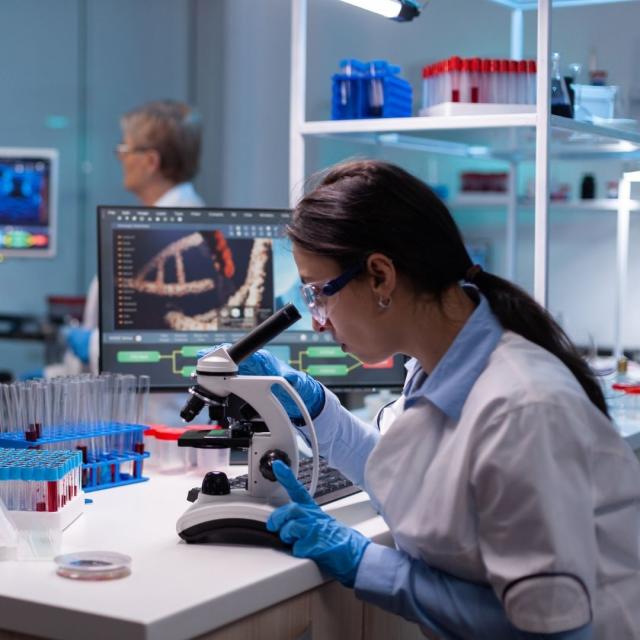From mannequins to virtual reality, simulation technology is a wide and ever-expanding area shaping the way health care is delivered.
So what is simulation technology? The definition can be broad.
At a basic level, simulation technology is when a computer represents the responses or behaviours of a real system it’s modelled on. Because simulation technology is often used to study or apply dynamic behaviours in response to situations that can’t be easily or safely applied in real life, it’s ideally suited to healthcare environments. Perhaps simulation technology’s greatest advantage is that it allows healthcare professionals to better facilitate patient safety.
Dr Vivienne Mak, a registered pharmacist and educator with expertise in developing educational programs, describes how simulation can be utilised in healthcare education as “anything that can simulate real practice for training purposes”.
“It could be where people simulate patients to recreate clinical scenarios; or the use of technology to recreate realistic, practical experiences, such as the use of mannequins or interactive videos,” Dr Mak says.
For Professor Debra Nestel, a professor of simulation education in health care at Monash University and professor of surgical education at the University of Melbourne, simulation technology is described as not a series of objects or devices, but a process.
“It creates opportunities for students and healthcare professionals to immerse themselves to various degrees in pretty much any aspect of their clinical practice with a view to perfecting, refining… it could even be doing, for the very first time, a new technique procedure. So it’s not even necessarily physical examination skills or operative or procedural skills, it can be communication, and it can be all of those things integrated together,” Professor Nestel says.
Let’s take a deep dive into how simulation technology is reshaping health care at a number of levels.
Types of simulation technology in health care
“Types of simulation technologies in health care may include everything from role playing clinical situations through to the use of mannequins that can show vital signs, as well as the use of virtual-reality or interactive videos,” says Dr Mak.
“These can range from low-to-high-fidelity healthcare simulations in training and assessment of clinical skills. High fidelity is basically where you have a patient scenario, that when you’re reproducing it, the realism is high level – so it could ignite the physical touch, affect psychological components and the environment feels real,” she explains. “Low-fidelity simulation may attempt to simulate scenarios, but lacks realism and components that make it feel real; and things like a case study or clinical vignette.”
Some of the more common forms of simulation technology used in healthcare education include ‘benchtop models’, which may represent part of the human body and will sit on a benchtop. Other common forms are ‘task trainers’ or ‘part-task trainers’, which are specialised models or programs designed to help a learner practise a specific skill4.
According to the Society for Simulation in Healthcare (SSH), there are four main purposes of simulation technology in the health field: education, assessment, research and health system integration.
Using simulation technology in health care
The main benefit of simulation technology is that it allows healthcare students to practise without causing harm to humans.
“Instead of testing blood pressure on the simulated patient’s arm multiple times in a day – because that’s just not feasible – you might have a simulated arm where you will be testing blood pressure, and behind the scenes you can control what the blood pressure reading could be,” explains Dr Mak. “So, the student will basically use a fake arm to do activities or exercises.”
“For dentists, you have fake teeth. For nurses, you have mannequins and different simulated clinical scenarios as well. And then more recently, the development of virtual reality allows one to immerse themselves in clinical situations, for example, virtual reality surgeries.”
Simulation technology also allows educators to manipulate conditions to replicate what healthcare students would experience as healthcare professionals in the field. In this way, Dr Mak says, it also helps prevent errors by training students to refine their responses.
“When we teach students how to dispense medications to make sure that it’s safe and effective, it can be difficult to simulate stress – when you’re stressed and multitasking, you’re more likely to make mistakes. So, via simulation, we can simulate stressful environments in a controlled fashion. Therefore, if a student dispenses the wrong medication, they can learn from their mistake without harming a real patient,” she says.
In healthcare settings, simulation technology has even wider implications. In hospitals, for example, simulation software can be used to audit processes and test changes before implementing them, while surgical robots are assisting in surgeries to maximise precision when making incisions.
Simulation examples in health care
Training surgeons
Laparoscopic surgery is one area where simulation technology is helping trainee surgeons hone their skills for common procedures, such as removing gallbladders.
“The simulator doesn’t bear much resemblance to what laparoscopic surgery really looks like, but you do hold real instruments,” Professor Nestel says. “The tasks that you do include moving like noughts and crosses onto a little board, but you’re using laparoscopic instruments. And you do threading, like tying a knot or a shoelace, and then you move up to much more sophisticated simulators.”
Training to prepare patients with trauma
It can be difficult to prepare healthcare students to manage situations where patients will be experiencing psychological challenges, such as trauma, but simulation technology is helping bridge that gap.
Oxford VR, a UK company, has created a virtual reality simulation that helps patients overcome fear and anxiety in social interactions. The platform gradually exposes patients – who would otherwise be socially avoidant – to social interactions in a safe and controlled environment. Preliminary results showed the simulation helped reduce patient anxiety by 68 per cent on average8 (Forbes, accessed July 2022).
Training frontline healthcare workers
As Professor Nestel mentioned, an important part of simulation technology is not just learning techniques but learning how to communicate effectively – and that includes managing patients who may not always be cooperative or pleasant. In one exercise Professor Nestel was involved with, junior doctors were told to give an intramuscular injection of antibiotics to a ‘patient’ who was aggressive and belligerent. For many of the doctors, they were so rattled by the patient’s behaviour they overlooked the drug chart, which showed that the patient was allergic to antibiotics. When the instructor pointed this out later, the doctors weren’t able to recognise their error initially – so the simulation recording was vital.
“I think there was something like 24 junior doctors who went through that exercise,” Professor Nestel recalls. “Some of them said, ‘I did not, that’s absolutely not the case, I checked!’ and they were mortified. And it was really important that they could watch it for themselves on the video. It was that ‘seeing is believing’ thing.”
Training for diverse community interactions
It’s very important for simulation technology companies to work with culturally and linguistically diverse communities to make sure they prepare healthcare professionals to meet those communities’ needs. At Monash University, Professor Nestel has been working with an Indigenous man to create scenarios that match meaningful experiences of Indigenous people in healthcare settings. Tech companies are starting to get on board to meet this need.
“It’s only really in the last decade that simulation simulator manufacturers have been increasing diversity of their benchtop models and task trainers,” Professor Nestel says.
Increasing digital literacy
Professor Nestel says there’s been a movement towards helping healthcare professionals become more digitally literate – via professional development courses and societies – so they’re better able to use these innovations such as simulation technology.
Dr Mak adds, “It comes back to training – the need to train not only health professionals, but anyone who will need to be upskilled on how to use these technologies and associated data to drive better patient outcomes.”
There also needs to be a greater understanding of how healthcare professionals can apply the digital information they may have access to – for example, data from health tracker devices such as Apple Watches.
“Pharmacy is a good example,” Dr Mak explains. “How can pharmacists access and utilise My Health Record to make informed clinical decisions and improve patient outcomes? There are many new developments in how we access patients’ health information and a lot of education and training needs to take place, not just for health professionals and students, but also for patients and consumers.”
Benefits of simulation technology
Dr Mak says simulation technology’s benefit for healthcare students is also helping them understand how their own emotions may affect their skills and performance – for example, the influence of personal struggles.
“I find that some simulation assessments can be challenging to administer,” she says. “If I have a dispensing exam with students where they use a pharmacy simulator, I can control the types of events that occur in the simulator and the environment where the students undertake the assessment. However, I can’t control some of the physical and/or emotional factors that can influence some of their decision-making. So, if a student did not sleep the night before, and they make a harmful mistake, at least they will get the feedback and you can say, ‘Okay, what do you think would have caused you to make this error and cause harm to this patient? Let’s talk this through.’ So at least they can reflect and be made aware of things that could influence their decisions.”
Research shows healthcare provision is already improving as a result of recent technological advances with simulation technology.
“Learning curves for operative skills are improved on laparoscopic simulators, and management of specific conditions are improved – fewer central line infections, better management of obstetric emergencies, for example,” Professor Nestel says.
A positive impact on healthcare professionals means better outcomes for patients. For example, a study of nursing staff over three months found that low-fidelity simulations improved their performance times, with a 52 per cent improvement in time to initiate chest compressions (StatPearls, accessed July 2022). A study to improve arrhythmia detection in emergency departments increased the rate of detection from 5 to 55 per cent, thanks to simulations.
Restrictions and issues
One of the major issues surrounding simulation technology is the cost. Dr Mak says that mannequins, for example, are very expensive for educators – also, organising classes and assessments can be resource intensive. Educators might need to hire people and create facilities to support individualised assessments in order to best utilise this technology.
“Specialised mannequins are very expensive, and for example, if the faculty only purchases one, you have one for 300 students, it’s time-consuming. So it can be more difficult than teaching and putting a video up on the screen,” she says. Simulation-based education access is another issue, adds Professor Nestel.
“Access to individuals trained to use simulation as an educational method is an obstacle,” she explains. “A good deal of my time is spent on this faculty development – Graduate Certificate of Clinical Simulation and Master of Clinical Simulation PhDs.”
Jobs in simulation technology
If you’re wanting to boost your own simulation technology capability, perhaps becoming a simulationist (someone with an education focus), many universities offer development programs and there are professional development courses available from many professional organisations, such as the Society for Simulation in Healthcare. The website healthsimulation.com can be a useful guide, Professor Nestel says.
“Simulation technology is just another educational method and it is increasingly integral to health professionals’ education,” she says.
If, however, you’re considering becoming a simulation technician, having a healthcare background is helpful, as is engineering and IT experience.
“It’s not just for health professionals, it’s also for those who are in health information technology – they might have a health background or they might not,” says Dr Mak. “I’ve had a lot of students in the past who became health professionals but were more interested in health technology, so moved on to further their studies in IT, potentially, to learn how they could use those skill sets to develop new technology for health.
Although simulation technology is not new – Professor Nestel points out that the first call for simulated endoscopy courses was made in the 1920s – the rate of technological advances is rapidly increasing, changing the face of health care.
Explore our range of online postgraduate health courses including counselling, leadership & management, mental health, nursing, psychology and public health to find one that suits you.
- Sources
- Royal Australian College of General Practitioners: Young people ‘embrace’ telehealth with their GPs
- Department of Health: Telehealth hits 100 million services milestone
- Commonwealth Scientific and Industrial Research Organisation: Better Access: substantial shift to telehealth for allied mental health services during COVID-19 in Australia
- Healthcare IT News: Does telehealth in Australia have a promising post-pandemic future?
- Royal Australian College of General Practitioners: Young people ‘embrace’ telehealth with their GPs






















